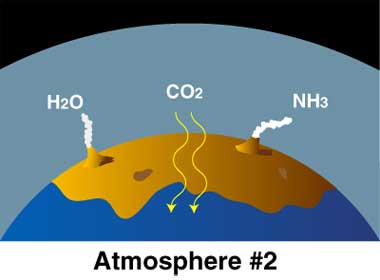Announcements
The revised version of Year Three Astronomy was published on February 25, 2025. Very few substantial changes were made from the old version, so you won't have to, or be able to, do any assignments you have already done in the old version except the final exam and ones you are retaking, but you should read all the lessons because the material in them will be tested on the O.W.L. exam and the N.E.W.T.
Lesson 5) An Invisible Shield
Welcome, class! As we can surmise from the previous lessons, Earth’s formation is something it has in common with all the other planets. Each formed from the same massive cloud, and several are formed from similar materials. Part of what makes Earth special is how it protects itself from the violent solar winds, space debris, and radiation that could tear everything apart. Earth’s atmosphere and magnetosphere work together to keep all life free from most celestial dangers.
Easy as 1, 2, 3!
Much like its surface, Earth’s atmosphere has changed greatly since the formation of the planet. First, physical processes, and then life itself, made these changes possible. The air we breathe today is very different from the air of early Earth. The planet is thought to have transitioned through three different atmospheric compositions, each defined by their elemental makeup and the processes that created and changed them.
Earth’s first atmosphere is comparable to those of a majority of the solar system’s other planets. For a brief moment after its creation, Earth was surrounded by hydrogen and helium - the most common, and lightest, elements in the universe. This atmosphere was thin and offered very little protection from space debris as well as the Sun’s rays and winds. If you were to perform magic on this version of Earth, your spell’s power would be very unpredictable: wild solar magic would cause a massive backfire, or the spell could be incredibly weak. Indeed, it was the shortest lived atmosphere, as these elements were soon blown away and scattered by solar winds.
Artistic interpretation of the first atmosphere
Source: here
The second atmosphere, also known as the prebiotic atmosphere, was the result of the turbulent period that preceded the formation of continents and oceans. As you learned last week, this period is known as the Hadean Eon, where volcanoes ruled and no life could be found. These volcanoes produced substances such as ammonia, carbon dioxide, sulphur dioxide, and water vapour, which formed the second atmosphere. Magic released by volcanoes is “wild” magic from deep inside the Earth, known to have many unintended consequences. It was released alongside the aforementioned gases, meaning that the ambient magic in the atmosphere was much stronger and had more unpredictable results than today’s magic. While this atmosphere was still inhospitable for most forms of life we see today, it still contained many of the building blocks for today’s atmosphere.

Artistic interpretation of the second atmosphere
Source: here
The first and second atmospheres were the result of geological processes involved with the formation of planet Earth. The third atmosphere is our current atmosphere. The atmosphere developed slowly over millions of years thanks to the early blossoming of life on Earth. The very first life that formed on our planet was made up of single celled plants called cyanobacteria. These plants used sunlight and the carbon dioxide from the second atmosphere to create sugar and oxygen; a process known as photosynthesis. The sugar was used as energy by the plant as it grew, while the oxygen was released into the air. Over time, most of the carbon dioxide in the atmosphere was replaced by oxygen. This process is known as the Great Oxidation Event. Today, the third atmosphere is made up of nitrogen, oxygen, argon, and traces of other gases, mostly carbon dioxide. The relative amounts of these gases are shown in the image below.
Atmospheric composition
Source: here
Layers Upon Layers
Unlike Earth’s layers, those of the atmosphere are made up of gases, so they are also defined by their density (mass per unit volume) in addition to their temperature.
Layers of Earth’s atmosphere
Source: here
The troposphere is the layer of Earth’s atmosphere we are most familiar with, because this is the layer where we live. It begins at the Earth’s surface, reaches a height of 11 to 12 miles (about 18 kilometres), and contains three quarters of the mass of the whole atmosphere and 99% of all water vapour on Earth. Temperatures here tend to be higher near the surface of the Earth, getting colder as you move to the edge of the troposphere. This is because this atmospheric layer is heated by the reflection of the Sun’s heat by the Earth’s surface. All weather on Earth happens within the troposphere, as you can probably assume given how much water vapour it contains! The movement of the air from the warmer lower area to the cooler higher altitudes and vice versa is what creates all of our storms and weather patterns. Without the troposphere, there also would be no breathable air to keep us and other plants and animals alive.
This is the layer that filters wild solar magic and makes it more stable, predictable, and uniform. By the time solar magic descends to about three miles, or less than 16,000 feet (about 5 km) above sea level, it’s as tame as it’s going to get.
The next layer is the stratosphere; it is much less dense than the troposphere but much larger, reaching from about 11 miles (about 17.7 km) up to approximately 30 miles (about 48 km) high and contains almost all of the remaining mass of the atmosphere. This layer is of particular importance to us on Earth because it is where the ozone layer resides. The ozone layer is a shield that absorbs a majority of the Sun’s ultraviolet radiation, which would otherwise greatly increase the incidence of skin cancer. This absorption of energy creates a lot of heat. Although temperatures are low where the troposphere meets the stratosphere, they rise dramatically the farther you move from Earth, starting with the ozone layer.
The mesosphere is the layer located on top of the stratosphere. It begins about 30 miles (48 km) away from Earth’s surface and extends to about 60 miles (96 km) away from the planet. Here, temperatures drop again as you move further away, as there are fewer molecules to absorb solar radiation. Due to the lack of molecules, the outer edge of the mesosphere is the coldest place in the atmosphere. There are still enough particles in this layer to interact with outside objects entering the atmosphere, though: most meteoroids bound for Earth burn up in this layer as they encounter massive amounts of friction with these mesospheric particles. Without this layer, a greater number of meteoroids would be able to hit the Earth, causing death and destruction.
The next layer is the thermosphere which begins about 60 miles (96 km) from Earth’s surface and reaches up to 300 miles (483 km) away. While this layer is actually very hot because it receives a lot of ultraviolet radiation from the Sun, this heat cannot be felt. Feeling heat requires hot, energetic molecules to transfer their energy to your skin. Since there are so few molecules in this layer, the energy cannot be transferred and heat cannot be felt. The image below shows the temperature of the various layers of the atmosphere up to the thermosphere.
Temperature of the layers of the atmosphere versus altitude
Source: here
Earth’s gravity is not only strong enough here to hold gas molecules; it can hold larger objects as well. This layer is most notable as the home of the International Space Station, where astronauts from around the world live and study in space.
The outermost layer, known as the exosphere, is the largest and least dense; it begins 300 miles (483 km) from Earth and ends about 6,200 miles (10,000 km) away. Here you can find stray molecules of hydrogen and helium, which rise to the top layer because they’re lighter than those that compose the rest of the atmosphere. Earth’s gravity still affects this layer enough to keep objects in orbit: here is where you will find most man-made satellites orbiting the planet. They are an advanced form of Muggle technology, allowing the transmission of information and images around the world very quickly.
Exosphere
Source: here
One Massive Magnet
While Earth’s atmosphere is a powerful, physical shield that can stop both solid objects and radiation from hurting us, the planet also has its own invisible armour. As mentioned before, the solar wind is a stream of particles from the Sun strong enough to blow away atmospheres. Earth’s magnetic field, however, can deflect these particles away from us to maintain our atmosphere.
Solar wind
Source: here
Earth’s magnetic field is generated by the Earth itself. It arises because of the way molten iron rotates between the inner and outer cores of the planet. The shifting of the iron creates a convective force that interacts with Earth’s natural electric field, generating a magnetic force through the centre of the planet, flowing from the north to south poles, so that the external magnetic field flows around the planet from the south back to the north. This is what makes Earth act like a planet-sized magnet! We can see this when we use a compass: the needle is magnetised so that it will always point towards the magnetic North Pole.
The magnetosphere is the region of space surrounding Earth where the dominant magnetic field is the magnetic field of Earth, rather than the magnetic field of interplanetary space. Here, charged particles are held in place by the magnetic field of the Earth. These particles interact with and deflect the solar wind around our planet. This interaction can be observed by the naked eye – auroras like the aurora borealis are created when solar wind collides with the magnetosphere. These collisions make the lights that we see rippling very high up in Earth’s atmosphere, usually the thermosphere.
Aurora borealis
Source: here
That will be all for this week. So far you have studied the formation of the Earth and its features, as well as how the Earth is able to protect the organisms that live upon it. There will be a short quiz to test your knowledge on the newest information and also a midterm test, focusing on all that we have studied so far this year. When you have completed all your assignments, stop by my desk for a slice of Earth layer cake!

Earth layer cake
Source: here
Original lesson written by Professor Gagarina.
- ASTR-201
Enroll
-
Y3 L5: Lesson Quiz
Quiz -
Y3: Midterm - Part 1
Test -
Y3: Midterm - Part 2
Essay
-
Velinea Nite
Head Student
-
Timothy Walsh
Professor's Assistant


